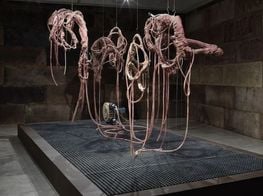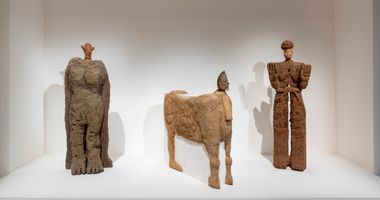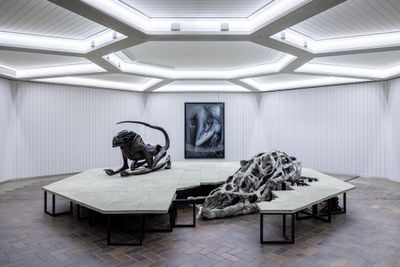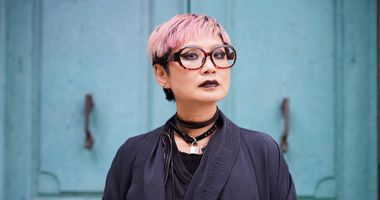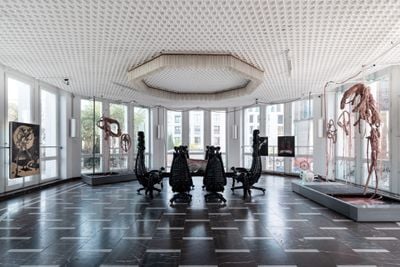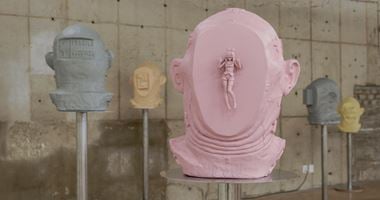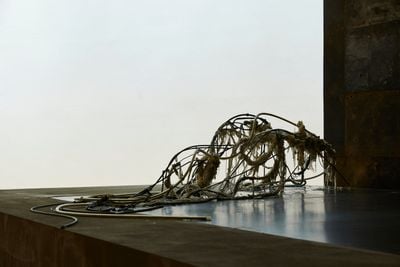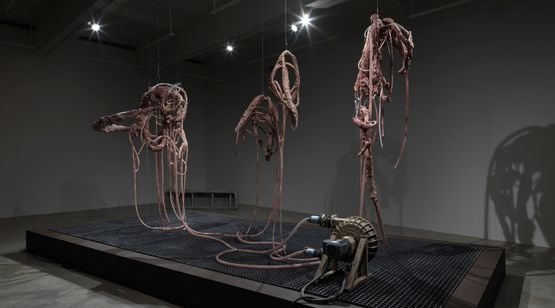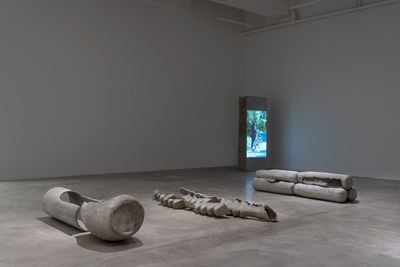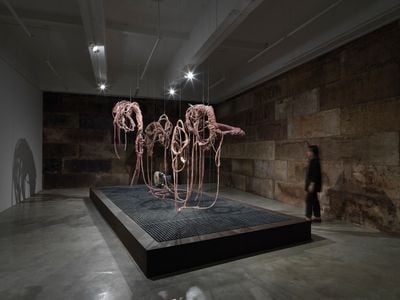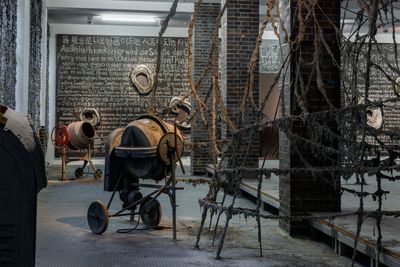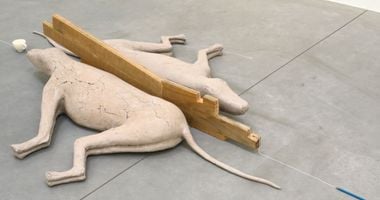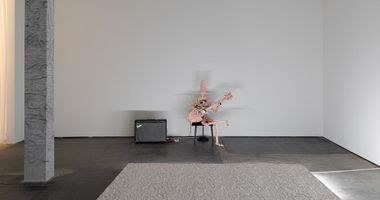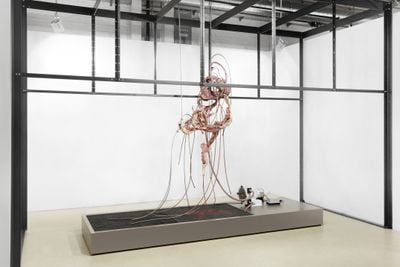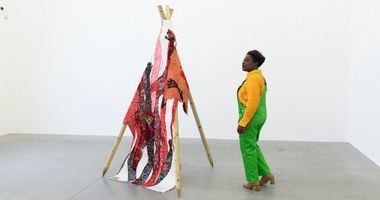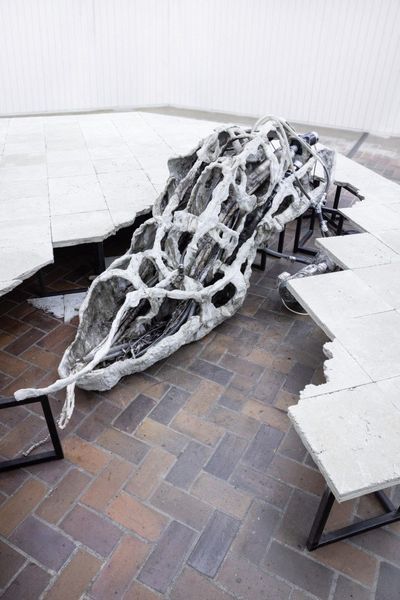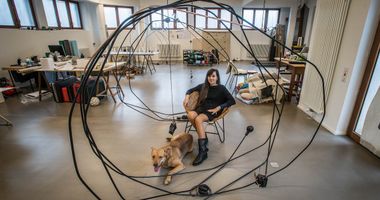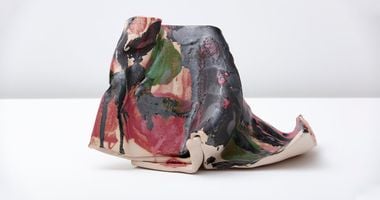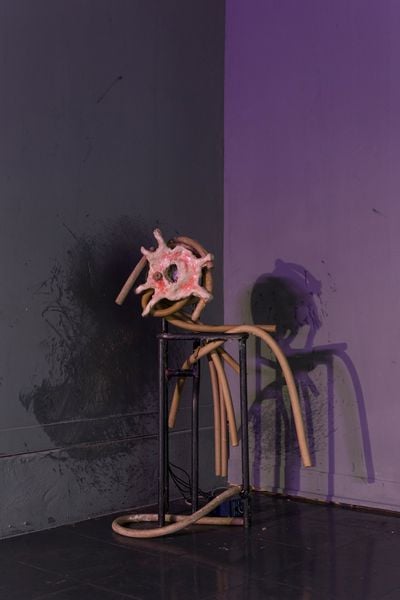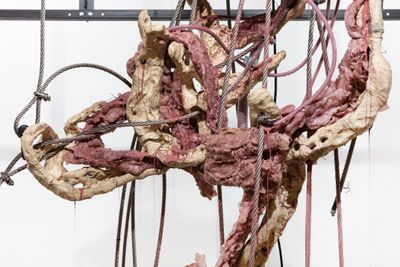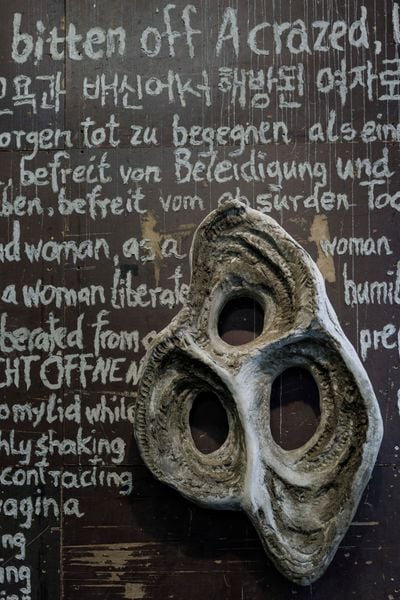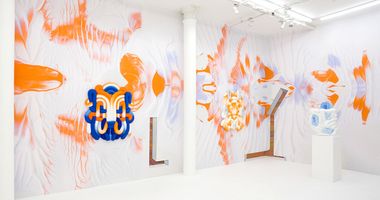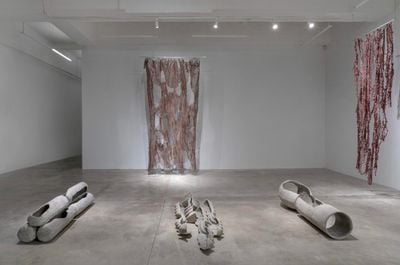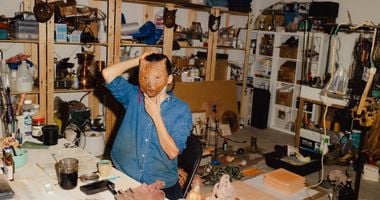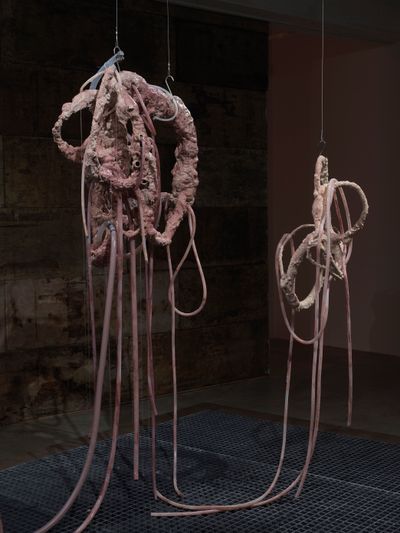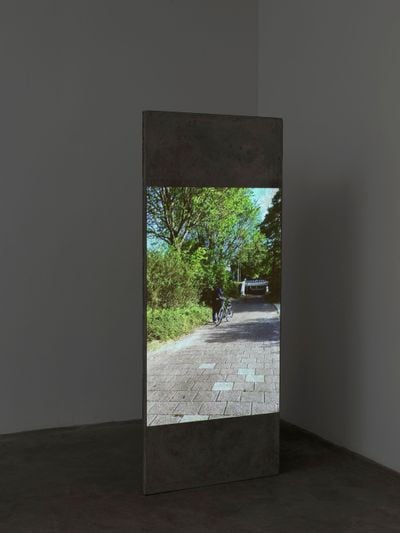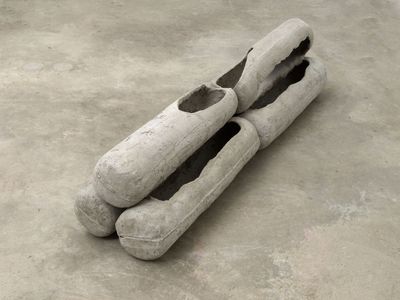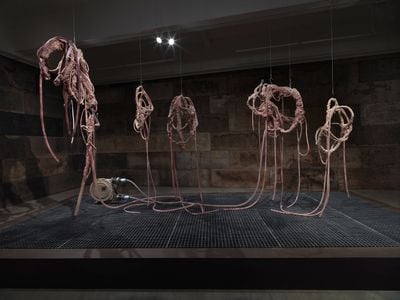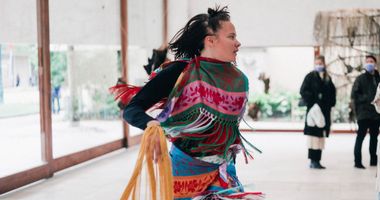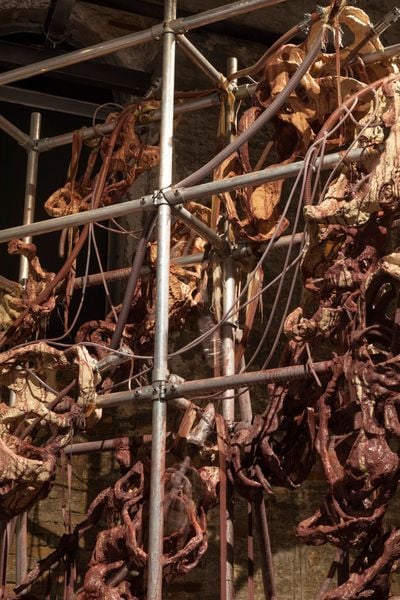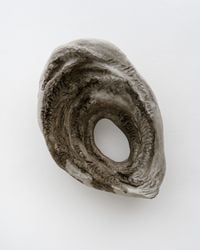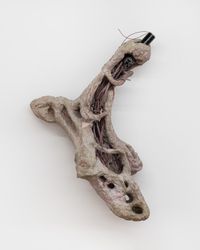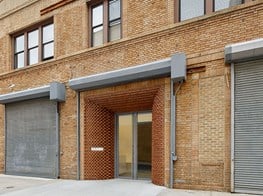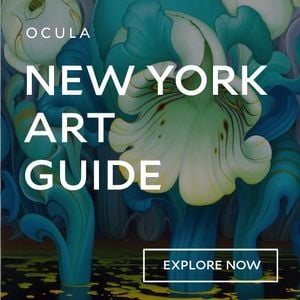Mire Lee’s Visceral Bodies
Mire Lee. Courtesy the artist and Tina Kim Gallery. Photo: Sebastiano Pellion di Persano.
Mire Lee. Courtesy the artist and Tina Kim Gallery. Photo: Sebastiano Pellion di Persano.
Mire Lee's kinetic sculptures are defined by a visceral, body-horror intensity, where materials like silicon and clay are paired with motors, metals, and oozing liquids to create quivering displays of corporeal abstraction.
A case in point is the artist's recent installation at the 59th Venice Biennale, The Milk of Dreams (23 April–27 November 2022), Endless House: Holes and Drips (2022). A tall metal scaffold positioned on a raised metal platform plays host to bisque-fired ceramic forms attached to poles with rope.
Organ-like ceramic forms act like intestines through and over which lithium carbonate and iron-oxide glaze drip down this anti-fountain, which is operated by a dialysis-like machine below.
Glaze is generally applied to a ceramic before its final firing, a process these glaze-soaked forms will undergo once the 59th Venice Biennale has closed.
Another sculpture by Lee titled Endless House (2021) was among the assemblage of bodily systems the artist created for Berlin's Schinkel Pavillon in 2021.
Part of a show pairing works by Lee and late Swiss surrealist H.R. Giger, the animatronic concrete form excreting liquid silicone from within was shown alongside a model of Giger's Xenomorph, best known as the lead character in Ridley Scott's 1979 movie Alien.
The title Endless House draws from Austrian-American architect Frederick Kiesler, whose surrealist drawings and models from the mid-20th century envisioned homes 'as elastic as the vital functions'—organic, ever-evolving, and interconnected spaces.
These ideas infuse Lee's artistic practice, where bodily functions and forms create the basis for sculptures whose structures draw from the vital functions of a living body.
The artist's 'Carriers' series (2020–2021), for instance, arranges P.V.C. hoses into intestinal bouquets, with pigmented glycerine coursing through them courtesy of a peristaltic pump. The latter mimics the wave-like process of peristalsis, where the muscles of a bodily canal constrict and relax to create a forward flow.
At the Schinkel Pavillon, three of these carriers, Carriers – offsprings (2021), were suspended from the ceiling, extending the artist's 2020 exhibition at Art Sonje Center in Seoul, where a series of 'Carriers' hung from the ceiling, and seemingly crawled on the floor.
Lee's first solo exhibition in New York with Tina Kim Gallery, Carriers (15 September–22 October 2022), features similar works. The exhibition takes place ahead of her participation at the 58th Carnegie International in Pittsburgh (24 September 2022–2 April 2023).
In New York, Lee will be showing the 'Carriers' sculptures from the Schinkel Pavillon, alongside a new version of Sleeping Mom (2020), a video of her mother sleeping, which extends the concept of a carrier from a bodily organ to a life-giving organism.
Lee discusses her Tina Kim Gallery and Carnegie International projects in the following conversation, as well as her arresting installation at the Venice Biennale.
She also discusses her recent PONTOPREIS MMK 2022 award exhibition at ZOLLAMT MMK in Frankfurt, organised by the MUSEUMMMKFÜR MODERNE KUNST (MMK) and the Jürgen Ponto Foundation for the promotion of young artists.
Speaking of that show, Lee elaborates on two fetishes that feed into her bodily depictions—vorarephilia, the desire to swallow or be swallowed by another, and coprophilia, a love of excrement—where excretions and their conduits intensify connections between body and being.
SBYour installation in Venice brought together a number of ideas that run through your work, maximising this kind of anti-figurative sculpture where the body gets turned inside out and splayed open. Could you talk about that?
MLI still haven't found a neat way to talk about this work because it was a mix of a lot of things and the medium was new for me. My knowledge of ceramics is quite vague. Of course, I am very used to clay, but for me, that knowledge had more to do with the changing malleability of the material.
I've been working on a lot of projects recently, and when you get a lot of projects the only way to make things happen is sometimes to maximise, or as you say, exaggerate your forms. Everything went a bit wilder in scale and concept this year. When I think for too long, I get passive, worry, and step back.
In Venice, there are scattered inspirations. I started with the idea of an endless house, which is a reference I've used a lot in previous works. I wanted to make a body with a lot of holes so that it becomes this container that lets everything out as soon as you put something inside.
The piece has a lot to do with the deformation of bodies. The idea of having a lot of holes in the work connects to being very open as a person, which represents vulnerability to me. It also represents strength, because when you are so open and exposed, you don't have any armour. You're out there, naked.
SBHow did you go about composing the form? Did you have these ideas in mind and sketched them out? Or did you work with materials intuitively?
MLMy relationship to research is a bit weird, I can't pinpoint an explicit reference. The work in Venice started with this very rare skin condition that some babies are born with. They're called Harlequin babies. Their skin feels like a very hard shell.
I found out about this condition while watching smoking-cessation videos, which led to the algorithm queuing up videos of bodies deformed from smoking. They are designed to trigger fear by showing you what will happen if you don't quit.
The YouTube algorithm wants to show you more and more videos and eventually, the trail led to the Harlequin babies. I was completely struck by the shells that compose their skin.
Another image I was very into is the photograph of the remains of a Soviet Union cosmonaut who died in space. He went to space knowing that the spacecraft he was in was defective. He is sitting in an open casket and it's very sculptural.
All these connections manifest at the tip of my hands; they get mixed together and I find this sensation to be incredibly productive.
I was so impressed by this image and thought it looked very similar to my Venice sculpture and the Endless House sculpture I showed at the Schinkel Pavillon. I used concrete but as I was making that work, I thought it would be nice to make it with ceramic.
SBWould you say there is a direct formal connection between the Harlequin babies and the Russian cosmonaut's corpse, and the bodies you created in Venice?
MLI think I often grow affection for my influences, whether they are cultural, biological, or material references.
All these connections manifest at the tip of my hands; they get mixed together and I find this sensation to be incredibly productive. The physicality, technicality, the conceptual, and the things I feel are one—I cannot separate them.
SBA classic form in sculpture is the figure, but your works feel like anti-figurations.
Take 'Carriers', which are silicon tubes arranged to look like hanging intestines. There is something visceral about seeing sculptures that look like organs. How did this material vocabulary develop?
MLIt started when I began working with lubricants. Then I experimented with motors, which you need to lubricate with grease to make sure they don't get stuck. First, the lubricant operates as a functional additional component to the work. Then, you start to use it excessively and everything gets out of control.
To borrow your expression, it's like I exploded in my own ways of making when I stopped thinking and judging the work.
SBWhat was the first sculpture you made using lubricant?
MLIt's a sculpture I did a long time ago, Hysteria, Catharsis, Elegance; the islands (2017). I wanted the sculpture to carry intensity and affect, so I tried different things to bring that out.
For a long time, I was terrified by the thought that I would stop existing, so I decided to approach that fear through art.
I liked using motor lubricant as if it were a paste. When you use it in chunks, it has volume and I found this to be very sculptural. I mixed it with plasticine, which is clay that doesn't dry.
Their forms change when you placed them next to a hard material and applied movement. I felt like this is what it should be; soft things are easily damaged and hard things are what damage them.
SBFrom there, you moved into silicone and rubber, and other materials that quiver and shake when you place them within motorised structures.
MLI feel very attached to materials that can be deformed and damaged, which open something for me conceptually and formally. I think the material's malleability connects to something more universal.
SBSpeaking of connecting to something more universal through the malleability of material, you have just staged a significant solo exhibition at the MMK in Frankfurt.
Thinking about your sculptures as malleable components relating to the body, and exhibitions as places that display an artist's body of work, what does this exhibition mean to you?
MLI am very fond of this show. I was able to use the whole space and treat the exhibition as one piece of work, more or less.
I am interested in this fetish called vorarephilia, which is about swallowing the other or being swallowed by the other. I've always wanted to make a show that gives you a feeling of going into the body of a huge animal like a whale.
The exhibition's title comes from a poem by a Korean poet, Kim Eon Hee. I am a huge fan and used many quotes from her poetry in the show. This close engagement with poems was a new way of working for me: it was the first time that I brought text directly into the space.
As part of the exhibition, I wrote Kim's quotes in concrete letters on the walls of the space at Zollamt MMK, which is a symmetrical cube. I thought about the action of picking up shit and smearing it, like when you lose yourself or lose your mind.
That action is linked to a small video I screened in another room, Veronica Moser (2022). Moser is a porn star who passed away in 2020 and whose work engaged in scatology. I find her very inspiring because shit is the lowest form in the human world and to be in love with that is the opposite of what most of us want.
SBThis relates to the exhibition's title, which is a line from Kim's poem, 'I am a fountain of filth raving mad with love'. Could you speak about that title in relation to vorarephilia, the fetish you were thinking about when working on the show?
MLVorarephilia is when you want to swallow the other being or the other way around—you want to be inside the other, to become one with them. It doesn't necessarily have to be humans; it can be animals, cars, buildings, or any entity.
Despite its infantile nature, it is a sexual fetish. No porn caters to people who engage in the fetish because it would be impossible to enact it. I find this very romantic. It's something you crave but can never get. You can only think about it.
SBThat seems to connect to this sense of excess that is expressed in your sculptures through their intensities, with these bodies that exist in visceral pieces. As with Carriers, which you are showing in New York with Tina Kim Gallery, right?
MLWhat I'm showing in New York is a variation of a show I did in Seoul in 2020 with Art Sonje Center, which not many people saw because it was during the pandemic.
The title of the show is Carriers, and it's composed of works from that series that are new productions. 'Carriers' are these sculptures made from silicone tubes that are connected to a peristaltic pump, so they ooze glycerine.
I feel very attached to materials that can be deformed and damaged, which open something for me conceptually and formally.
The pump works the same way as animal intestines: the motor pushes the hose inside to suck in substances and discharge them. My initial focus was on the sonic, so the sculptures make a sound as they suck in the air and release it.
In the other room, I have horizontal sculptures on the ground, which have an open belly. Their vertical pairs are closed forms that are not physically present in the exhibition. I also have a video of my mother in the Seoul show because she is my carrier.
Last time, the video showed my mother sleeping. This time she is doing casual things, like riding a bicycle or cooking.
SBYou've described the notion of the carrier as a metaphor. Anything can be a carrier, from your mother who gave birth to you to the formwork boards that build moulds for pouring concrete, which you've described as birthing the concrete façades of buildings.
This idea manifests in your alchemical sculptures: everything surrounding us is constantly giving birth to something else.
MLThose formwork boards are really important to me. I asked for them to be used at MMK, but they were not the ones I like to work with. Normally, when these boards are heavily used, you can see the concrete chunks that are stuck to them; they're very torn and look exhausted.
I like construction-site aesthetics—of industrialism, but in a nostalgic way. Because there are so many stupid hopes in them, many big ideas that kind of fell flat. It's the same with futurism, which connects to the kind of vision a construction site can often project of the future, of building something new.
There is something beautiful about the hopes and dreams that drove futurist ideas. It's also sad because of how oblivious everyone was about how everything would become so ugly and monstrous.
SBWith that in mind, what will you be showing at Carnegie International? Pittsburgh kind of encapsulates this post-industrial nostalgia you just described.
MLI wanted to do something with metal after visiting Pittsburgh. I normally love metal and metalwork but have mostly used it for practical reasons until now. This time, I used it aesthetically to create a decagon cylinder that contains a rotating axis.
SBIn terms of practicalities, moving and installing your works must be crazy. Do you have instructions or detailed diagrams?
MLIt's difficult. I have to be there to instal the work most of the time. I have tried to write an installation manual but never managed to fully write it out. It's really a problem.
SBDid you go to Venice with a plan, or did you conceive of the final form of the installation as you were putting it together in place?
MLGenerally, it depends. But in the case of Venice, when the work is tall and involves a lot of heavy gear, you have to plan so that no one gets hurt. I had a very clear image of what the sculpture would look like, but the final touches were improvised.
This had a lot to do with how much liquid we could use or could work, and the details around that, like the placement of the ceramic tubes. It was about working with the material as it flowed through the system that we had devised, playing with how wet things could get, and seeing how much you could exaggerate or play with the composition.
I installed the work with a very capable team of friends, mostly. It took around two or three weeks to complete. It's not that the work itself is very difficult, but we had to be inside the sculpture, working out the details as the liquid ran through it, which made everything feel harder.
SBTo be inside the body of your sculpture is kind of fitting, given your sculptures seem to turn the body inside out. Where did this journey into the body begin for you?
MLMy oldest fixation is a fear of death. For a long time, I was terrified by the thought that I would stop existing, but as a fixation, it can get a bit much, so I decided to approach that fear and deal with it through art. Since then, I have been working vigorously, and it feels good. —[O]

